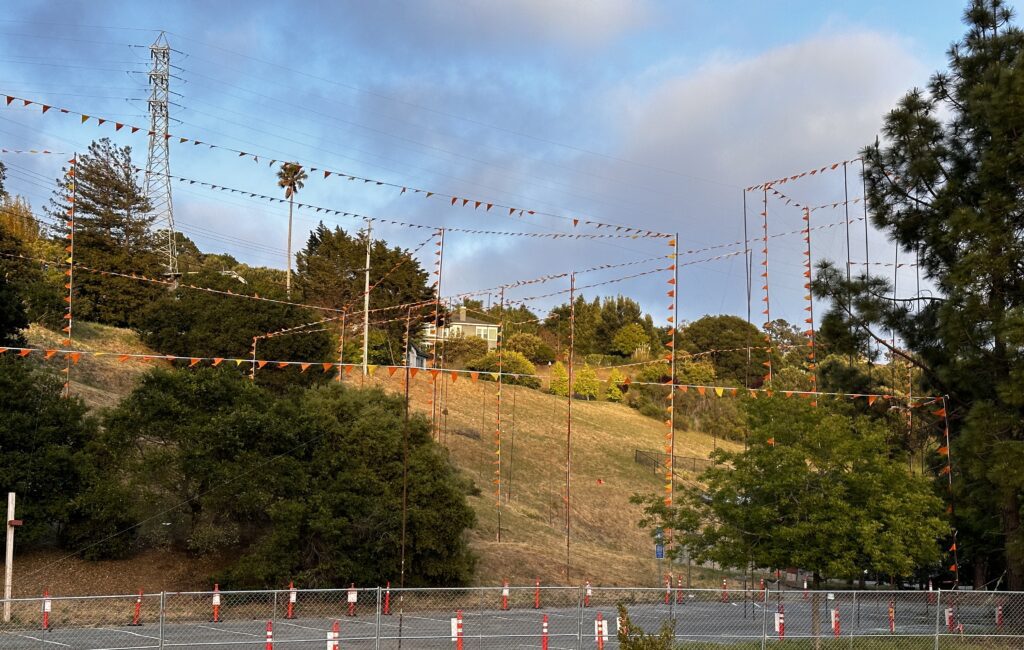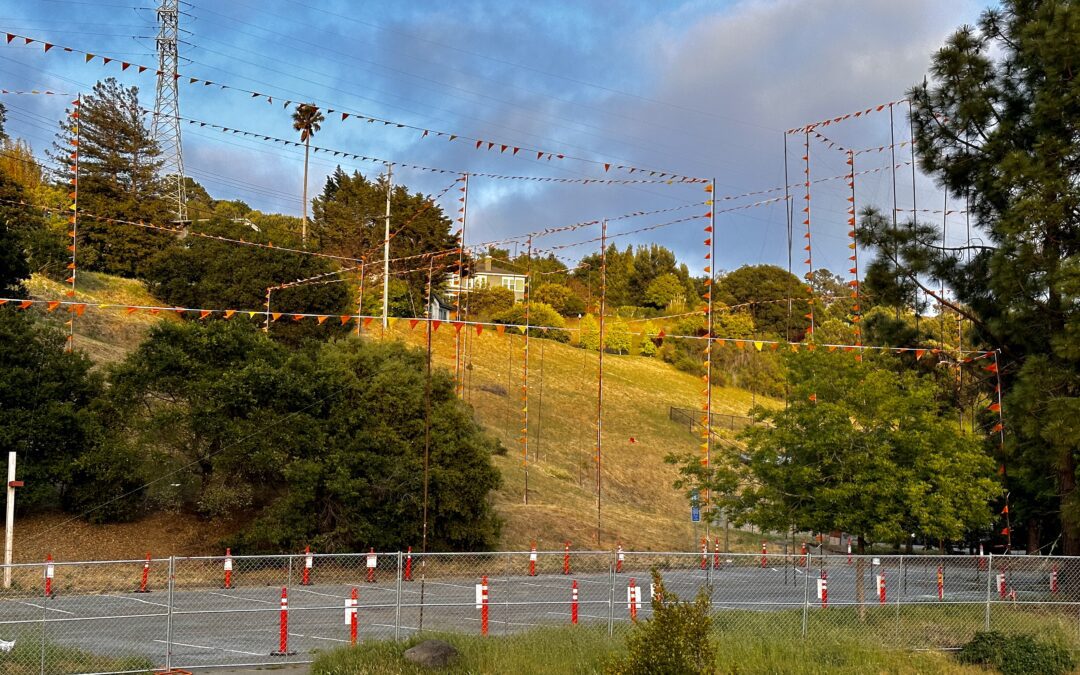
A view of the story poles for the proposed 1 Hamilton housing development.
If at first you don’t succeed…
After a comprehensive two-year public engagement process that included 12 public meetings, several community workshops, and online surveys, the City of Mill Valley’s Housing Element has been approved by the State of California’s Department of Housing and Community Development (HCD). “The approval of the Housing Element marks an important milestone and reflects the City’s commitment to a vibrant, welcoming, small town community that embraces diversity in housing, income levels, and lifestyles,” Mayor Urban Carmel said. Learn more about this important milestone.
In earlier hearings, councilmembers reviewed the recommended changes and clarified the goals of the housing programs, adding demographic data to sections and updating the inventory of development sites. The council received comments from the state at the end of July.
City Manager Todd Cusimano told those attending the hearing that “California cities have been put between a rock and a hard place with the deadlines and penalties that come with non-compliance,” he said. “We are now, like most California cities, headed toward that deadline coming in January, and the ramifications for not meeting those are catastrophic for cities.”
“We have been really careful, and I have been proud of our staff and our council and city attorney on our process of public engagement that has gone on throughout this process,” he added. “There are no new goals or policies being implemented in the latest update to the plan. The changes that staff are recommending are administrative and technical in nature,” and quite limited.
The revisions include changes to the sites inventory, fair housing and constraints sections. That includes the removal of the 60 Throckmorton Ave site – the project known as the Treehouse in the former Bank of America building because of a pending application to occupy that building.
City staff also added a section that analyzes the city’s housing needs and demographics, additional data regarding housing type and characteristics — such as if occupants are married or single, and if they have children.
The state commented on the city’s mandated housing numbers, stating that the city needs to better spotlight the shortfall. The table was adjusted to clearly highlight the section to better identify it. The accessory dwelling units were also adjusted from 20 a year to 21 because of new data.
Under the state’s housing mandate, the city must permit 865 more residences during the next eight-year planning cycle. The mandate includes 262 residences for very-low-income households, 151 for low-income households, 126 for moderate-income households and 326 for above-moderate-income households.
Mill Valley is planning for 969 dwellings, including 289 for very-low-income households, 185 for low-income, 151 for moderate-income and 344 for above-moderate households.
Changes to the sites inventory include adding information on development trends in Mill Valley and describing the characteristics of the SB 9 parcels. SB 9 is a law that allows property owners to split lots for up to four dwellings.
The fair housing section was changed to reflect a demographic analysis. One finding in the analysis was that “Mill Valley lacks diversity within the entire city and is considered a segregated community.”
The revisions included identifying priorities in fair housing, contributing factors and their level of priority, which are: a lack of progress in furthering fair housing; racially concentrated areas of affluence citywide; discrimination in the home sales market and disparities in home ownership; and community opposition to affordable housing.
“I think it’s important for the city to prioritize what we can do,” Staude said. “The first and foremost is to try to provide more affordable housing of different types throughout the community.”
This is the third round of revisions since the council began working on the element in September 2021.
“We started on the housing element more than two years ago,” Mayor Urban Carmel said. “This has been a long process and we’ve been going through this for a long time.”
The latest hearing on the Housing Element have kept city staff busy maintaining momentum on efforts to both plan for massive amounts of new housing mandates between now and 2031, and to see through their intentions to build affordable housing at 1 Hamilton Drive project with EAH Housing on city-owned land.
On May 18, the City Council voted unanimously to approve a revised housing element for submission to the state, including a certified environmental impact report for the general plan and amendments to the general plan land use element and land use map. To comply with the state housing mandate, the city must permit 865 more residences during the next eight-year planning cycle.
The mandate calls for 262 residences for very-low-income households, 151 for low-income households, 126 for moderate-income households and 326 for above-moderate-income households, while city officials are planning for 961 dwellings, including 287 for very-low-income households, 183 for low-income, 149 for moderate-income and 342 for above-moderate.
In addition to the aforementioned 1 Hamilton plan, the housing element identifies 401 Miller Ave., the complex that’s home to Sol Food and Simple Mills, as well as the large property on East Blithedale Ave. owned by Comcast building. City officials added that property owners interested in the redevelopment include Mill Creek Plaza, Sloat Garden Center, the former Jolly King Liquor store site and the former KFC/Taco Bell building. The city also plans on 16 residences developed under SB 9, a state housing law that allows property owners to split lots for up to four dwellings, according to the Marin Independent Journal.
As for 1 Hamilton, the Mill Valley Planning Commission held a study session – a chance for all stakeholders to have their say without a definitive final vote attached to the process – and focused on some concerns about the overall design of the project. That process will continue in the coming weeks.
1 Hamilton has faced consistent opposition from residents in the Enchanted Knolls neighborhood and adjacent areas, but councilmembers have sought to dispel the notion that a development at 1 Hamilton Drive would be the lone effort to address the City’s efforts to create conditions for more affordable housing. Hamilton Drive-area residents have pushed City officials to explore other neighborhoods and housing opportunities before doing so in their part of town, which has a history of multi-use and some affordable developments.
Councilmembers have countered that the Hamilton Drive site shows the most promise as a City-owned parcel in proximity to transit corridors and commercial areas, but that all other options are on the table. “This is not going to be the only site we will look at for affordable housing,” Councilmember Urban Carmel added in September, noting that other sites, like the Edgewood Reservoir, the Miller Avenue commercial corridor and areas around the Mill Valley Golf Course and Boyle Park tennis courts, are potentially on the table.
City officials have made it clear that they are serious about pulling every lever possible to create the conditions that would significantly expand on the approximately 6,670 current housing units and support the amount of additional housing for which they’re on the hook, according to ABAG.

